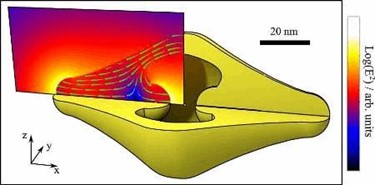Hollow Optical Antennas For Superior Photon Creation And Control
By Jof Enriquez,
Follow me on Twitter @jofenriq

Scientists at Julius-Maximilians-Universität (JMU) Würzburg in Bavaria, Germany, have introduced a novel plasmonic cavity antenna design that enhances the creation and control of photons emitted by atoms and molecules.
First described in 1959 by the Nobel Laureate Richard P. Feynman, nanoscale optical antennas are capable of sending photons in a specific direction with high efficiency, making them ideally applicable in making light-emitting devices and displays, single-photon sources for quantum computers, spectroscopic devices, and super-resolution optical microscopes.
Analogous to radio and microwave antennas, the purpose of optical antennas is to convert the energy of free propagating radiation to localized energy, and vice versa. For many years, optical antenna design has been based largely on radio-frequency rules and existing models of radio antennas. These are typically made of metal wires and rod arrays in the centimeter scale, and feature a cable linking the antenna to a high-frequency generator.
At the nanometer scale of optical antennas, however, the link has to be contactless. Thus, atoms and molecule photon emitters do not have cables that hook them up to an optical antenna. This, along with the unique properties of light waves that make them different from radio waves, is what makes an optical antenna less effective in creating and controlling photons from single-photon sources.
Würzburg scientists say they now have addressed this limitation with a novel plasmonic cavity antenna design exhibiting much improved performance compared to a reference two-wire antenna. The new optical antenna operates under a new set of rules developed by the research team.
"The idea behind this is based on the principle of similarity," explains Thorsten Feichtner, a researcher at JMU’s Institute of Physics. "What's new in our research is that the currents of the free electrons in the antenna have to fulfill two similarity conditions at the same time. Firstly, the current pattern in the antenna must be similar to the field lines in the direct vicinity of a light-emitting atom or molecule. Secondly, the current pattern must also match the homogeneous electrical field of a plane wave as best as possible so that each photon can reach a distant receiver."
Feichtner worked with Silke Christiansen and Bert Hecht on the research study.
In Physical Review Letters, the authors add, "We combine reciprocity and Poynting’s theorem to derive a set of optical-frequency antenna design rules for benchmarking and optimizing the performance of optical antennas driven by single quantum emitters."
The Würzburg physicists claim that their optimized optical antenna can produce "far more photons from an emitter than previous antenna types derived from radio technology," and will find myriad value, ranging from quantum optics to antenna-enhanced single-emitter spectroscopy, and sensing applications.
